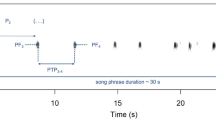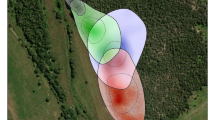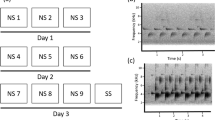Summary
The “dear-enemy” relationship of territorial songbirds could be mutually beneficial to neighbors, as males who recognize neighbors and reduce their responses to these neighbors would require less time and energy for territorial defense. In order for this relationship to be evolutionarily stable, this reduction in response to a neighbor must be conditional on reciprocal restraint by that neighbor. This study examined the possibility of such conditional responses in hooded warblers (Wilsonia citrina). Responses of territorial hooded warblers to playbacks of neighbors' songs from shared boundaries were measured before and after playbacks that simulated intrusions of those same neighbors (NNNN treatment) or strange birds (NSSN treatment) into the subjects' territories. Each male received both treatments separated by at least 8 days. Males increased their responses to playbacks of a neighbor's songs at the boundary after simulated intrusions of that same neighbor (NNNN) but did not increase their responses to such playbacks after simulated intrusions of strangers (NSSN). This increased response to a “defecting” neighbor suggests that the relationship between neighboring territorial hooded warblers is based on a conditional strategy like tit-for-tat.
Similar content being viewed by others
References
Axelrod R, Hamilton WD (1981) The evolution of cooperation. Science 211:1390–1396
Brindley E (1991) Response of European robins to playbacks of song: neighbour recognition and overlapping. Anim Behav 53:1412–1420
Cheney D, Seyfarth R (1990) How monkeys see the world. University of Chicago Press, Chicago
Falls JB (1982) Individual recognition by sounds in birds. In: Kroodsma D, Miller E (eds) Acoustic communication in birds. Academic Press, New York, pp 237–278
Falls JB, Brooks R (1975) Individual recongition by song in white-throated sparrows. II. Effects of location. Can J Zool 59:2380–2385
Fisher J (1954) Evolution and bird sociality. In: Huxley J, Hardy A, Ford E (eds) Evolution as a process. Allen and Unwin, London, pp 71–83
Fox SF, Baird TA (1992) The dear enemy phenomenon in the collared lizard Crotaphytus collaris, with a cautionary not on experimental methodology. Anim Behav 44:780–782
Getty T (1987) Dear enemies and the prisoner's dilemma: why should territorial neighbors form defensive coalition? Am Zool 27:327–336
Getty T (1989) Are dear enemies in a war of attrition? Anim Behav 37:337–339
Godard R (1991) Long-term memory of neighbors in a migratory songbird. Nature 350:228–229
Koenig WD (1988) Reciprocal altruism in birds: A critical review. Ethol Sociobiol 23:395–399
Lombardo MP (1985) Mutual restraint in tree swallows: an experimental test of the TIT for TAT model of reciprocity. Science 227:1363–1365
Lombardo MP (1990) Tree swallows and TIT FOR TAT. Ethol Sociobiol 11:521–528
McGregor PK, Avery MI (1986) The unsung songs of great tits (Parus major): learning neighbours' songs for discrimination. Behav Ecol Sociobiol 18:311–316
Nowak MA, Sigmund K (1992) Tit for tat in heterogeneous populations. Nature 355:250–253
Parker GA (1984) Evolutionarily stable strategies. In: Krebs JR, Davies NB (eds) Behavioural Ecology. Sinauer, Massachusetts, pp 30–61
Qualls CP, Jaeger RG (1991) Dear enemy recognition in Anolis carolinensis. J Herpetol 25:361–365
Rothstein S, Pierotti R (1988) Distinctions among reciprocal altruism, kin selection, and cooperation and a model for the initial evolution of beneficent behavior. Ethol Sociobiol 9:189–209
Spector D (1992) Wood-warbler song systems. In DM Power (ed) Current ornithology vol 9. Plenum Press, pp 199–238
Stoddard P, Beecher M, Horning C, Campbell S (1991) Recognition of individual neighbors by song in the song sparrow, a species with song repertoires. Behav Ecol Sociobiol 29:211–215
Trivers R (1971) The evolution of reciprocal altruism. Q Rev Biol 46:35–57
Trivers R (1985) Social evolution. Benjamin Cummings, New York
Wiley RH, Wiley MS (1977) Recognition of neighbors' duets by stripe-backed wrens, Campylorhynchus nuchalis. Behavior 62:10–34
Wilkinson GS (1988) Reciprocal altruism in bats and other mammals. Ethol Sociobiol 23:85–100
Ydenberg RC, Giraldeau LA, Falls JB (1988) Neighbours, strangers, and the asymmetric war of attrition. Anim Behav 36:433–437
Ydenberg RC, Giraldeau LA, Falls JB (1989) Remarks on Getty's “Fighting to learn” hypothesis. Anim Behav 37:336–337
Author information
Authors and Affiliations
Rights and permissions
About this article
Cite this article
Godard, R. Tit for tat among neighboring hooded warblers. Behav Ecol Sociobiol 33, 45–50 (1993). https://doi.org/10.1007/BF00164345
Received:
Accepted:
Issue Date:
DOI: https://doi.org/10.1007/BF00164345




